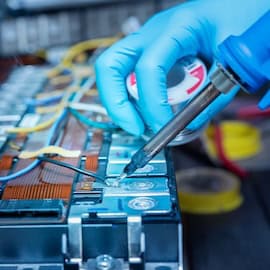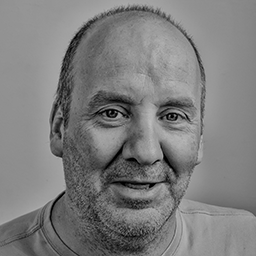A few years back, amidst the bustling solar energy scene in Ethiopia, a rather disheartening trend caught my eye. I was working with several international solar companies that were building their operations across the country, and my job brought me into contact with the local importers and distributors that were bringing these solar products to remote rural communities. Behind their warehouses, tucked away in forgotten corners or sitting on the shelves of rural shops, I would regularly see mountains of discarded solar home systems gathering dust.
The reason those places were full of broken or discarded solar equipment was because they simply didn’t have what they needed to fix them: no spare parts, no trained technicians, and definitely no proper tools for handling lithium-ion batteries safely. So when something went wrong — often just a minor battery issue — there was no way to troubleshoot or repair it. Customers would return the systems, importers or distributers would stash them away in storage, and over time, those once-useful products turned into useless stock before ultimately being discarded.
But these products weren’t just old equipment; they were once lifelines that provided affordable energy access to rural households. Over a decade, I’d seen over 200,000 of these units light up Ethiopian homes. I saw how transformative they were at first … and then noticed how many of them started failing, often within just a couple of years. I couldn’t ignore the pattern I kept seeing: Systems that could’ve been repaired or upgraded were being abandoned far too soon. Making matters worse, not only were these units no longer serving local communities, it was clear that they were exacerbating the country’s ever-growing e-waste problem — and there was no real solution in sight.
That was the turning point. It sparked a question that has shaped my subsequent career path: What if these systems didn’t have to meet such an early demise?
The Untapped Potential Hidden Within E-Waste
After seeing the scale of the issue firsthand, I made the difficult but necessary decision to leave my job. I felt a strong sense of responsibility: not just to talk about the problem, but to be part of the solution. Quitting gave me the freedom to focus fully on this challenge, roll up my sleeves, and begin the hands-on work of testing and reviving discarded solar systems. It was a leap of faith, but one I knew I had to take.
From that point, I began small. I bought my first batch of 800 broken solar home systems from a local warehouse. Most of them were units returned by customers due to issues that weren’t fixed in time, and some had never even made it to the end user because they were found to be defective before being sold. That initial purchase gave me a chance to really understand the types of faults involved, and to test whether refurbishment was possible. It was the first real step in turning my idea into action.
I set up a workshop in a cramped space right next to my Addis Ababa office and enlisted the help of two technicians, armed with just a few basic tools. We worked long hours, meticulously taking apart each system, testing every single component and learning from our mistakes.
We had our fair share of setbacks in the beginning, but we slowly found our rhythm. With each successful repair, our confidence grew. Eventually, we were able to revive an impressive 80% of the salvaged units. That experience taught me two invaluable lessons: There is immense, untapped potential hidden within this e-waste, and this value could form the foundation of a sustainable business model.
And so, in 2022, I put my savings on the line and launched Inter Ethiopia Solutions, a venture centered on the circular economy. Our goal was simple: to breathe new life into discarded solar and lithium-ion battery products by refurbishing and reselling them, lowering the environmental impact of e-waste, and providing clean, affordable energy to the communities that needed it most.
A Circular Economy Solution for Solar Energy
Today, Inter Ethiopia Solutions, operating out of Addis Ababa, stands as a pioneer in the circular economy. To my knowledge, we’re the first business in Ethiopia to take a truly systematic approach to refurbishing solar home systems and repurposing lithium-ion batteries into second-life energy products. What makes our model unique is that it combines technical innovation with grassroots distribution and a strong circular economy focus. We’ve even applied for a patent to protect the refurbishment method we’ve developed, which covers everything from diagnostics and repairs to tracking and warranty services.
We specialize in refurbishing solar home systems and creatively repurposing lithium-ion batteries to offer cost-effective energy solutions for off-grid areas. Where regular repurposing might involve reusing a functional battery in another solar home system (something which is valuable in itself), our approach pushes the boundaries. We take second-life lithium-ion cells and redesign them into completely new configurations with different voltages, capacities and management systems — for example, custom battery kits for powering small business use cases that were never part of the battery’s original life cycle. This requires both technical innovation and a deep understanding of community needs. It’s about transforming waste into entirely new energy solutions that serve local economic development.
Through this model, we’ve turned discarded waste into a valuable resource, collecting thousands of systems, meticulously testing and repairing them, and then returning them to the market at prices that are 40–60% lower than new imports. Every refurbished lithium-ion battery product is barcoded and logged into our custom inventory system, enabling us to track its journey, handle warranties efficiently and provide reliable after-sales support. Our team has grown to include 16 skilled professionals with expertise in electronics, logistics, renewable energy and marketing. We work in collaboration with rural shops, local agents and NGOs, which are involved in both the sale of refurbished units to remote customers and the sourcing of failed units to be refurbished. These partnerships help to ensure that our repaired systems reach even the most remote areas.
Inside Our Solar System Restoration Process
Every used solar system tells a story. Most have faithfully served a rural family until a small fault rendered them unusable and turned them into “waste.” A common example is a single dead lithium-ion cell inside a battery pack: Once one cell fails, the whole system stops working, even if the rest of the pack is still healthy. Another frequent issue is corroded wiring or a broken switch, which disconnects the flow of power.
These are the kinds of faults that are easily repairable if you have the right tools, spare parts and technical skills — and that’s where our real work begins. We carefully disassemble these failed units, sorting parts and separating damaged or outdated components. Our technicians then put each lithium-ion battery cell through rigorous testing, measuring its capacity, checking its performance, and using advanced refurbishment and grading techniques to identify the ones that can still be used.
Once graded, we rebuild these batteries into robust 12V or 24V packs. However, this isn’t just a simple reconnection; we equip them with advanced battery management systems to ensure safety and long-term performance. These systems don’t include smart diagnostics or digital alerts — instead, we rely on a hands-on, community-driven approach. Once a product is sold, our team closely follows up with the customer to ensure it’s working as expected. If a battery unit or solar home system show signs of malfunction, we provide prompt warranty support or repairs, replacing broken parts, skillfully rewiring connections and performing comprehensive diagnostic tests to ensure their reliability. Most problems can be solved quickly by our technicians, who are trained to handle common failures without the need for expensive new components. So we may not be using “smart tech,” but our system is smart in another way: by staying close to the ground, listening to our users and building trust through consistent after-sales service.
With support from the PREO program, we’ve significantly scaled up this process. Our facility now has state-of-the-art testing machines and specialized workstations. Our latest innovation, backed by PREO, involves building 600 second-life 1kWh battery packs, designed for productive use applications such as cold storage, irrigation and rural micro-businesses. This marks a meaningful evolution from our original approach, as our work initially focused on refurbishing solar home systems for basic household use. With this new model, these are no longer just household energy products; they are catalysts for business.
Refurbished Solar: A Model for Change
Like any circular innovation, our company has faced its share of hurdles. Initially, limited access to quality testing tools and spare parts threatened the viability of our repairs. We overcame this by importing essential equipment and training a local team of technicians from the ground up.
Earning trust in refurbished products has been another major challenge. Many of our customers had been disappointed by previous solar purchases, due to failed systems and a lack of after-sales support — even when buying brand new units. We tackled this with warranty guarantees, barcoding for traceability and a dedicated support line.
Looking ahead, scaling across regions will bring new issues, such as logistics coordination, standardization of quality and navigating inconsistent e-waste regulations across borders. We’re preparing by building local partnerships, formalizing our internal processes and advocating for supportive policies.
We’re motivated by the fact that our work is making a tangible difference. We’ve refurbished over 3,000 solar systems, diverted 25 tons of e-waste from landfills, developed new battery packs to power appliances used by smallholder farmers and other local businesses, and created numerous jobs. Our efforts directly support crucial United Nations Sustainable Development Goals, including SDG 7 (Affordable and Clean Energy), SDG 12 (Responsible Consumption and Production) and SDG 13 (Climate Action).
But our vision extends beyond solar batteries. As diesel cars are phased out and replaced by electric vehicles in Ethiopia, we anticipate a surge in battery waste and are actively preparing to manage these new types of batteries. We’re also piloting circular solar kiosks: community hubs where local entrepreneurs handle repairs, sell refurbished systems and collect e-waste for responsible recycling. It’s our way of anchoring the circular economy closer to the people, while planting the seeds for expansion into markets like Kenya and Uganda through trusted local partnerships.
Given the growing demand for our services and the interest we’ve garnered from potential partners, I truly believe that our journey is just beginning. What started as an idea has grown into a national platform for sustainable energy. I hope our story inspires others to ask: What if energy systems didn’t have to die? What if we could give them, and the people who depend on them, a second chance?
Zelalem Nigatu is the Founder and CEO of Inter Ethiopia Solutions PLC.
Photo credit: Fahroni, iStock Photo
Publisher: Source link






